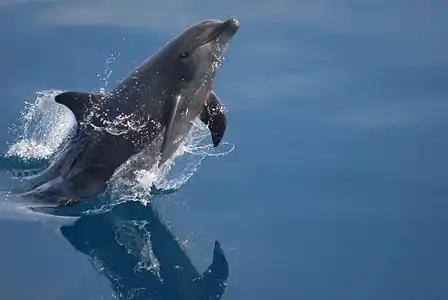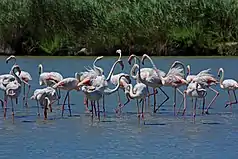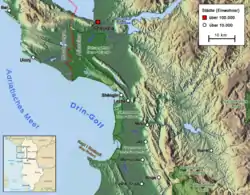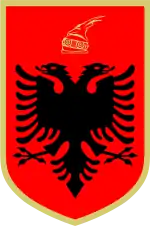Albanian Adriatic Sea Coast
The Albanian Adriatic Sea Coast (Albanian pronunciation: [brɛˈɡdɛ:ti adriˈa:tik] — Albanian: Bregdeti Adriatik) stretches in the Southeastern Adriatic Sea beginning at the Gulf of Drin in the north, across the port cities of Shëngjin, Durrës and Vlorë, to the Bay of Vlorë in the south, where the Albanian Riviera as well as the Albanian Ionian Sea Coast begins.
| Albanian Adriatic Sea Coast | |
|---|---|
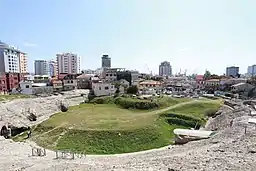 | |
 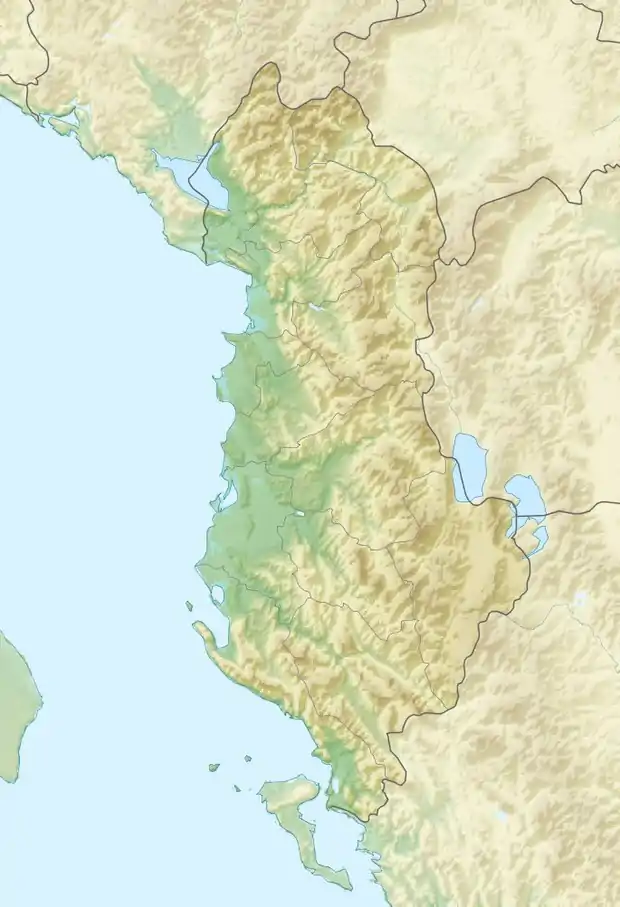 | |
| Location | Adriatic Sea in Albania Southern Europe |
| Coordinates | 40°20′10″N 19°27′46″E |
| Length | 274 kilometres (170 mi) |
| Geology | Beach |
Albania is geographically located in South and Southeast Europe within the Balkan Peninsula. It borders on Montenegro to the northwest, Kosovo to the northeast, the Republic of Macedonia to the east, Greece to the south and the Mediterranean Sea to the west. The total length of the coastline is approximately 274 kilometres (170 mi), 178 kilometres (111 mi) of which are taken up by white sandy beaches and the remaining by different landforms.[1][2][3]
The Adriatic Sea is the northernmost arm of the Mediterranean Sea merely extending all the way from the Strait of Otranto in the south up to the Po Valley in the north.[4] The sea is apportioned into two major basins, wherein Albania is entirely located within the deepest and southernmost one. The coastline is one of the wealthiest scenery of the country in terms of biology, holding an outstanding diversity of ecosystems and biodiversity found within a precious mosaic of wetlands, estuaries, capes, sand dunes, marshlands, forests and marine habitats.
At different times, numerous ancient people, most notably the Illyrians[5][6] and later the Ancient Greeks and Romans, have established significant settlements around the shores. They were considerably influenced by their direct proximity to the sea because it provided routes for trade, colonization and war, as well as food; the Via Egnatia, that crossed through the mountains of Albania, was at that time among the most significant routes in the Roman Empire.
The coastline is populated by more than 1.500.000 million people. The most sizable cities are Durrës and Vlorë placed in the north and south, respectively.[7] Durrës is served by Port of Durrës, one of the largest on the Adriatic Sea, which connects the city to Italy and other neighbouring countries within the Adriatic.
Environment
Geography
Albania is geographically located on the Balkan Peninsula in South and Southeast Europe bordered by the countries of Montenegro to the northwest, Kosovo to the northeast, the Republic of Macedonia to the east and Greece to the south and southeast. The western edge touches the Adriatic and Ionian Sea, both within the Mediterranean Sea. The majority of the country's territory consists of mountains and hills, making Albania one of the most mountainous countries of Europe. Likely the Albanian Alps runs in the north the Korab Mountains in the east, the Ceraunian Mountains in the south and the Skanderbeg Mountains in the center, while the plains and plateaus are principally to be found in the west.
The Albanian Ionian Sea Coast is known for its rugged natural beauty, with rocky highlands and a great marine life, while the Albanian Adriatic Sea Coast consist of sandy beaches and shallow coastal waters hosting a great wildlife. Administratively, the Albanian Adriatic coast is shared between the counties of Shkodër in the north, Lezhë, Durrës, Tirana, Fier and Vlorë in the south.
The Albanian Adriatic Sea Coast begins from the estuary of Buna whitin the Gulf of Drin at the border with Montenegro, passes through Myzeqe Plain, the capes of Rodon, Turrës, Gjuhëzes, the cities of Shëngjin, Durrës, Vlorë, the estuaries of Drin, Mat, Ishëm, Erzen, Shkumbin, Seman, Vjosë and the lagoons of Karavasta, Narta Kune-Vain-Tale and Patoku, until it reaches the Bay of Vlorë. Numerous rivers flowing into the Adriatic Sea form bays, lagoons and limans. The sand and silt they bring are deposited in the areas of reduced flow, that is the sides of the bays, forming narrow sandbanks.
Biodiversity
In terms of phytogeography, the Albanian Adriatic Sea Coast belongs to the Illyrian province of the Circumboreal Region within the Boreal Kingdom. It falls entirely within the Illyrian deciduous forests terrestrial ecoregion of the Palearctic Mediterranean forests, woodlands, and scrub biome. The special environmental circumstances and the millennial human activity on the territory of the coast determine the rich variety of species, populations and ecosystems, many of which are with conservation significance.
The Albanian Adriatic portion features contrasting vegetation types that are impacted by different factors. The woodlands are mostly dominated by evergreen forests with associated broadleaved sclerophyllous evergreen trees and shrubs primarily found in the southern section of the coastline.[8] The forests ranges from mixed broadleaf forests, at lower elevations, to conifer forests, at higher elevations.[9] The pine forms an important natural feature within the coastline, distributed across Velipoja, Shëngjin, Patok and Rodon, which in turn provide habitat for a vast array of wildlife.[10]
Stretching in the southeastern Adriatic Sea, the coast with a wealth of important habitats makes for a fascinating birdwatching location during peak migration with several wetlands, estuaries and hills provides diversity for both resident and migrant birds.[11] Maybe the most iconic bird of the coast is the vulnerable and extremely rare dalmatian pelican.[12] It breeds on inland lakes and coastal lagoons of Albania such as in Karavasta and Patoku Lagoon.[13][11] The greater flamingo is another prominent and important species that live in the region. It is the largest species of flamingos and widespread in Karavasta and Narta Lagoon.[14]
The coast is famous for wildlife watching and nesting sea turtles are one of the region's highlights. Its beaches provide nesting sites for several species of endangered sea turtles, namely the hawksbill, leatherback, green sea and loggerhead sea turtle.[15][16][17][18] As well as turtles, the sea life consist of several species of sharks, dolphins and whales. The cuvier's beaked whale and sperm whale are common along the coast. The dolphin species found along the entire coastline are represented by the striped dolphin, risso's dolphin and common bottlenose dolphin.[19][20]
The vast and diverse coast is home to an incredibly rich diversity of mammals. Most famous of the carnivores is the rare golden jackal that occurs mostly on the coast of the ravines of the rivers.[21][22][23] Another notorious might be the red fox, which occurs throughout the forested and coastal areas in the northern section of the coast.[24] Other mammals include the brown bear, wild boar, chamois and grey wolf. The sea, lagoons and river deltas are extremely rich in salt and fresh water fish. Some aquatic and abundant animals include the european sea sturgeon, starry sturgeon, twait shad and adriatic sturgeon, which is perhaps the most famous species to become extinct in the Adriatic Sea.[24]

The protected areas of Albania are a biodiversity treasure, containing a wide range of geographical and climatic diversity. Different categories of protected areas have been established alongside the coast. Divjakë-Karavasta National Park, the only national park in the Albanian Adriatic coast, is very picturesque and harbors several endangered species, that makes it a very popular place indeed.
Encompassing the Drin River estuary, the Kunë-Vain-Tale Nature Park is an undisturbed natural area of wet grasslands, swamps and lagoons at the direct proximity to the Adriatic Sea. The Vjosa, considered to be Europe's last wild river, discharges, north of Narta, into the Adriatic Sea, where it forms the Vjosa-Narta Protected Landscape.[27] Both the Karavasta Lagoon and Lake Shkodër are classified as wetlands of international importance by designation under the Ramsar Convention.[28][29][30]
Important Bird Areas are important sites for bird conservation and their habitats, as they provide suitable conditions to birds. Currently, 16 important bird areas have been identified throughout the territory of Albania, amongst them the Drin Delta near Shkodër, the Vlorë Bay, that is bordered by Karaburun-Sazan Marine Park, and the lagoons of Patoku, Karavasta and Narta, that are among the largest and most important coastal wetlands of the Balkans, due to its varied biodiversity and one of the top sites for wintering and migratory birds in the country.[31][32]
Climate
Apart from the considerable variation in landscape, it makes for a wide range of climate types. The Adriatic Sea in the west, Albanian Alps in the north and Ceraunian Mountains in the south have a great influence to the climate of the area. As defined by the Köppen climate classification, the Albanian Adriatic Sea Coast experiences a mediterranean climate with considerable maritime and subtropical influences. This means that the summers are hot, sometimes very hot and dry and the winters generally mild and wet. The coast experiences four distinct seasons. The winter is relatively humid and mild, and the summer lasts very long and is usually hot and dry. Autumn and spring are transitional seasons.[2]
Winds in the Adriatic Sea change their direction and speed during a year period as a result of the distinctive mediterranean climate. This characteristic is mainly determined by a passing trajectory of basic systems across the Mediterranean Sea and Balkan Peninsula as well as other important factors such as morphometric characteristics of the territory.
| Climate data for Durrës | |||||||||||||
|---|---|---|---|---|---|---|---|---|---|---|---|---|---|
| Month | Jan | Feb | Mar | Apr | May | Jun | Jul | Aug | Sep | Oct | Nov | Dec | Year |
| Average high °C (°F) | 11.4 (52.5) |
12.5 (54.5) |
14.9 (58.8) |
18.3 (64.9) |
22.6 (72.7) |
26.5 (79.7) |
28.7 (83.7) |
28.8 (83.8) |
26.0 (78.8) |
21.4 (70.5) |
16.6 (61.9) |
13.3 (55.9) |
20.1 (68.1) |
| Daily mean °C (°F) | 8.1 (46.6) |
9.0 (48.2) |
10.9 (51.6) |
14.0 (57.2) |
18.1 (64.6) |
21.8 (71.2) |
23.8 (74.8) |
23.9 (75.0) |
21.2 (70.2) |
17.2 (63.0) |
13.0 (55.4) |
9.9 (49.8) |
15.9 (60.6) |
| Average low °C (°F) | 4.8 (40.6) |
5.6 (42.1) |
6.9 (44.4) |
9.7 (49.5) |
13.6 (56.5) |
17.2 (63.0) |
19.0 (66.2) |
19.0 (66.2) |
16.5 (61.7) |
13.0 (55.4) |
9.5 (49.1) |
6.5 (43.7) |
11.8 (53.2) |
| Average precipitation mm (inches) | 132 (5.2) |
107 (4.2) |
99 (3.9) |
81 (3.2) |
68 (2.7) |
41 (1.6) |
26 (1.0) |
36 (1.4) |
71 (2.8) |
112 (4.4) |
160 (6.3) |
131 (5.2) |
1,064 (41.9) |
| Source: [33] | |||||||||||||
Economy
Tourism
_-_Monument_of_Agonothetes.JPG.webp)
Tourism is considered one of the largest industries in the economy of Albania.[34] It has significantly increased since following the fall of communism in the country.[35] The country has a rich historical and cultural heritage and natural beauty varying from clear turquoise waters fringed by sandy and rocky beaches to contrasting mountainous interior. The coastline has a well-preserved natural ecosystem that can boast a unique combination of a diverse climate and landscape.
As Albania extends over the Adriatic flyway, birdwatching is recently gaining in popularity, due to the interest shown by visitors from other countries.[36][37] The coastline has a lot to offer fr both visiting and resident bird watchers.[38] The extensive wetlands, with many different Mediterranean and European species, contains many significant birding sites throughout the year. The lagoons in Karavasta, Patoku, Narta and various other protected areas are just a few examples of popular birdwatching destinations.
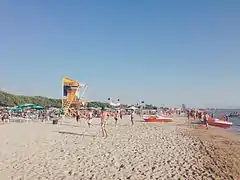
Beach vacations, particularly for domestic and foreign visitors from different countries, are also central to the local tourism industry. Most beach resorts are located especially along the coastline of Durrës and Vlorë. The southern coastline of Durrës are renowned for its traditional mass tourism, which have experienced an uncontrolled urban development. In contrast, the northern coastline are mostly unspoiled and set to become an elite tourism destination. In addition, the area is gaining international attention through the organization of music festivals such as the UNUM International Music Festival in Rana e Hedhun, Shengjin.[39]
The heritage tourism is focussed on specific interest on the history of Albania, such as the architectural heritage of ancient civilizations such as the Illyrians, Ancient Greeks and Romans in Albania. Besides the churches, mosques, forts and historical buildings, the most popular heritage tourism attractions are the remains of the ancient city of Apollonia, the ancient fortress of Rozafa and the amphitheatre of Durrës.
Transport
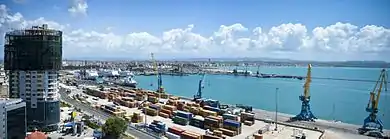
The Albanian Adriatic Sea Coast is home to the three largest seaports of the country. The largest cargo ports among them is the Port of Durrës, one of the largest in the Adriatic Sea, with annual passenger volume of approximately 1.5 million. The other seaports include Vlorë and Shëngjin. In addition, the ports serve a wide system of ferries, connecting numerous islands and coastal cities in addition to ferry lines to several cities in Croatia, Greece and Italy.
Yachting is pretty recent in the country and less developed than in other countries within the Mediterranean Sea. Porto Albania will be after its complementation, the first marina destination in Albania for both national and international yachting and charter.[40] It will be located between the city of Durrës and the national park of Divjakë-Karavasta.
See also
| Wikimedia Commons has media related to Albanian Adriatic Sea Coast. |
References
- Sustainable Development of Sea-Corridors and Coastal Waters: The TEN ECOPORT project in South East Europe (Chrysostomos Stylios, Tania Floqi, Jordan Marinski, Leonardo Damiani ed.). Springer. 2015-04-07. p. 85. ISBN 9783319113852.
- Pano Niko, Frashe˛ri Alfred, Avdyli Bardhyl and Hoxhaj Fatos. "Impact of the Climate Change on Adriatic Sea Hydrology" (PDF). itc.upt.al. p. 385.CS1 maint: multiple names: authors list (link)
- "OUTLOOK ON SEAWATERS DYNAMICS AND GEOLOGICAL SETTING FACTORS FOR THE ALBANIAN ADRIATIC COASTLINE DEVELOPMENTS" (PDF). itc.upt.al. p. 1.
- "Adriatic Sea" (PDF). arctic.ucalgary.ca.
- Cunliffe, Barry (2008). Europe Between the Oceans. Yale University Press. pp. 115–116. ISBN 978-0-300-11923-7.
- Wilkes, John J. (1995). The Illyrians. Oxford: Blackwell Publishing. pp. 91–104. ISBN 0-631-19807-5.
- "SOME CONSIDERATIONS ON SEAWATER-FRESHWATER RELATIONSHIP IN ALBANIAN COASTAL AREA" (PDF). igme.es. Tirana. p. 2.
- "DISTRIBUTION OF MAMMALS IN ALBANIA" (PDF). catsg.org.
- "420: Southeast Adriatic Drainages". feow.org. Archived from the original on 2017-01-16. Retrieved 2018-06-18.
- Protection of Coastal Areas of the Adriatic Sea: Proceedings : Colloquy Organised Within the Framework of European Nature Conservation Year 1995 in Co-operation with the Ministry of Health and Environment of Albania, Tirana, Albania, 27-29 October 1994. Council of Europe, 1995. 1995-01-01. p. 68. ISBN 9789287128515.
- "Conservation Status of Albanian Coastal Wetlands and their Colonial Waterbird Populations (Pelecaniformes and Ciconiiformes)" (PDF). vliz.be. Brussels. pp. 1–10.
- Euronatur. "Dalmatian Pelicans". euronatur.org.
- IUCN Red List. "Pelecanus crispus (Dalmatian pelican)". iucnredlist.org.
- BirdLife International and IUCN Red List. "Phoenicopterus roseus (Greater Flamingo)" (PDF). datazone.birdlife.org. p. 3.
- "Loggerhead turtles (Caretta caretta) foraging at Drini Bay in Northern Albania: Genetic characterisation reveals new haplotypes" (PDF). fupress.net. Tirana, Albania. pp. 1–8.
- IUCN. "Sea turtles in the Mediterranean: Distribution, threats and conservation priorities" (PDF). rac-spa.org. pp. 23–36.
- "Report on the status and conservation of the Leatherback Turtle Dermochelys coriacea" (PDF). cms.int.
- "Distribution records of sea turtles in the Montenegrin waters" (PDF). ucg.ac.me.
- United Nations Environment Programme MEDITERRANEAN ACTION PLAN. "STATUS AND CONSERVATION OF CETACEANS IN THE ADRIATIC SEA" (PDF). cbd.int. p. 22.
- "Inland observations of Common Bottlenose Dolphins Tursiops truncatus (Montagu, 1821) in the delta of the Bojana/Buna River, Albania and Montenegro" (PDF). dlib.si. pp. 1–4.
- World Wide Fund for Nature Greece. "Conservation Action Plan for the golden jackal (Canis aureus) in Greece" (PDF). wwf.gr. p. 8.
- Marco Masseti (2012-10-30). Atlas of terrestrial mammals of the Ionian and Aegean islands. Walter de Gruyter, 2012. p. 107. ISBN 9783110254587.
- Euronatur. "Rapid assessment of the Ecological Value of the Bojana-Buna Delta (Albania / Montenegro)" (PDF). euronatur.org.
- IUCN. "Request for Proposals Design and realization of museological exhibits for the Buna River Protected Landscape and the Shebenik-Jabllanicë National Park visitor centres in Albania" (PDF). iucn.org. p. 44.
- "The natural wealth and legacy of the Drin River Basin: inspiring our collective actions" (PDF). act4drin.net. p. 7.
- "Drin River Basin The blue heart of the Balkans" (PDF). mio-ecsde.org. p. 4.
- Fred Pearce. "Scientists demand halt to damming of Europe's last wild river". newscientist.com. Retrieved 23 September 2016.
- Ramsar Convention. "KARAVASTA LAGOON MANAGEMENT PLAN". ramsar.rgis.ch.
- "Raport Paraprakë Vleresim Ndikimi Në Mjedis" (PDF). akm.gov.al (in Albanian). p. 12.
- Ramsar Convention (7 February 2006). "Albania designates its share of Lake Shkodra". ramsar.org.
- BirdLife International. "Albania". datazone.birdlife.org. p. 1.
- BirdLife International. "Important Bird Areas and potential Ramsar Sites in Europe" (PDF). birdlife.org. pp. 18–19.
- "Climate: Durrës". Climate-Data.org. Retrieved February 2, 2018.
- "TOURISM AND EMPLOYMENT IN ALBANIA – IS THERE A STRONG CORRELATION?" (PDF). asecu.gr. pp. 1–9.
- Eglantina Hysa - Epoka University. "INFLUENCE OF TOURISM SECTOR IN ALBANIAN GDP: ESTIMATION USING MULTIPLE REGRESSION METHOD" (PDF). researchgate.net. Tirana. pp. 1–6.
- Euronatur. "Adriatic Flyway". euronatur.org.
- Euronatur. "ADRIATIC FLYWAY - BIRD CONSERVATION ON THE BALKANS" (PDF). euronatur.org.
- Lonely Planet. "Albania develops birdwatching in Adriatic wetlands to boost tourism" (PDF). lonelyplanet.com.
- HOLDEN, AARON. "UNUM IS A NEW FESTIVAL HEADING TO ALBANIA NEXT MAY". MixMag. Retrieved 8 November 2018.
- "Porto Albania – Erster Mega-Yachthafen Albaniens: Startschuss für Bauarbeiten fällt". aussenden.com (in German). 18 May 2017.

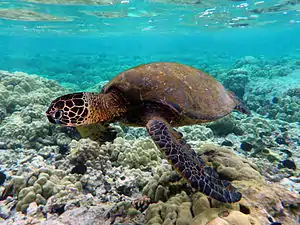
.jpg.webp)
_in_Divjak%C3%AB-Karavasta%252C_Albania.jpg.webp)
